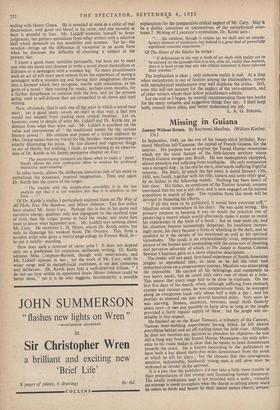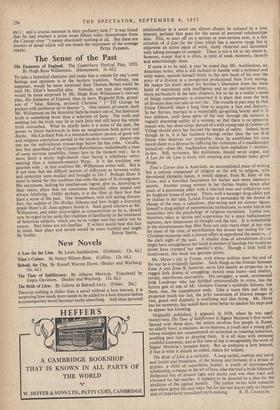Missing in Guiana
Journey Without Return. By Raymond Maufrais. (William Kimber. 15s.) IN September, 1949, on the eve of his twenty-third birthday, Ray- mond Maufrais left 'Cayenne, the capital of French Guiana, for the interior. His purpose was to explore the Tumul Humac mountains which are the main feature of the little-known territory where French Guiana merges into Brazil. He was inadequately equipped, almost penniless and suffering from toothache. His only companion was a mongrel dog ; in the end he ate it, afterwards suffering frightful remorse. His diary, in which the last entry is dated January 13th, 1950, was found, together with his rifle, camera and some other gear, by an Indian in the following month. Nothing has been heard of him since. His father, an employee of the Toulon Arsenal, remains convinced that his son is still alive, and is now engaged on his second expedition in search of him. The royalties from this book will be devoted to financing his efforts. " If all this were to be published, it would bore everyone stiff," Maufrais wrote somewhere in his diary. He was quite wrong. His primary purpose in keeping it was no doubt the practical one of. preserving a record which would afterwards make it easier to recast his experiences in the form of a book ; but as time went on, and his situation became increasingly desperate, his loneliness increas- ingly acute, his diary became a form of whistling in the dark, and he confided to it the details of his emotional as well as his spiritual vicissitudes. The result is an extraordinarily vivid, impressionistic picture of the human spirit contending with the same sort of daunting . and pervasive adversity of which, in The Jungle is Neutral, Colonel Spencer Chapman gave us a more objective description. . The reader will not need first-hand experience of South American jungles to apprehend that, as soon as he left the river and embarked alone on a cross-country journey, Maufrais was attem pting the impossible. He carried all his belongings and equipment in- two heavy packs, but he could only carry one of them at a time. This meant that every stage had to be done in triplicate. On the first five days of his march, when, although suffering from stomach cramps and various sores, he was comparatively fresh, he averaged along an overgrown track only about half a mile a day ; and his journey as planned ran into several hundred miles. Very soon he was starving. Snakes, monkeys, tortoises, small birds (latterly eaten raw)—it was just possible to keep alive as long as the jungle provided a fairly regular supply of these ; but the jungle was un- reliable in this respect. He. finished up on the River Tamouri, a tributary of the Camopi. Various boat-building experiments having failed, he left almost everything behind and set off wading down the little river. Although he does not mention any decision to abandon his objective—he was still a long way from the Tumul Humac Mountains—his only refer- ence to his route makes it clear that he meant to head downstream towards the coast. He is known (according to the publishers) to have built a but about thirty-five miles downstream from the point at which he left his diary ; but the chances that this courageous,. sensitive, indomitable, foolhardy young, man is still alive must be reckoned as slender in, the extreme.
It is a pity that the publishers ci'd not take a little more trouble in their presentation of this strange and fascinating human document. The totally inadequate map is not provided with a scale ; virtually no attempt is made to explain what the diarist is talking about when he refers to birds and beasts by their native names (hocco, acriara etc.) ; and a crucial sentence in their prefatory note (" it was found that he had reached a point some fifteen miles downstream from the Camopi river ") means absolutely nothing at all. But these are matters of detail which will not lessen the enjoyment of the average



































 Previous page
Previous page